- Home
- Oliver Sacks
The man who mistook his wife for a hat
The man who mistook his wife for a hat Read online
The man who mistook his wife for a hat
* * *
The man who mistook his wife for a hat
OLIVER SACKS
Who
MISTOOK
HIS WIFE
for
a HAT
and other clinical tales
To Leonard Shengold, M.D.
THE MAN WHO MISTOOK HIS WIFE FOR A HAT AND OTHER CLINICAL TALESCopyright © 1970,
1981, 1983, 1984, 1985 by Oliver Sacks. All rights reserved. Printed in the United States of America. No part of this book may be used or reproduced in any manner whatsoever without written permission except in the case of brief quotations embodied in critical articles and reviews. For information address HarperCollins Publishers, 10 East 53rd Street, New York, NY 10022.
Library of Congress Cataloging-in-Publication Data Sacks, Oliver W.
The man who mistook his wife for a hat and other clinical tales.
Bibliography: p.
1. Neurology-Anecdotes, facetiae, satire, etc. I. Title.
[RC351.S195 1987] 616.8 86-45686
ISBN 0-06-097079-0 (pbk.)
Contents
Preface page vii
Part One - LOSSES Introduction page 3
1 The Man Who Mistook His Wife for a Hat page 8
2 The Lost Mariner page 23
3 The Disembodied Lady page 43
4 The Man Who Fell out of Bed page 55
5 Hands page 59
6 Phantoms page 66
7 On the Level page 71
8 Eyes Right! page 77
9 The President's Speech page 80
Part Two - EXCESSES Introduction page 87
10 Witty Ticcy Ray page 92
11 Cupid's Disease page 102
12 A Matter of Identity page 108
13 Yes, Father-Sister page 116
14 The Possessed page 120
Part Three - TRANSPORTS Introduction page 129
15 Reminiscence page 132
16 Incontinent Nostalgia page 150
17 A Passage to India page 153
18 The Dog Beneath the Skin page 156
19 Murder page 161
20 The Visions of Hildegard page 166
Part Four - THE WORLD OF THE SIMPLE
Introduction page 173
21 Rebecca page 178
22 A Walking Grove page 187
23 The Twins page 195
24 The Autist Artist page 214
Bibliography page 234
Preface
The last thing one settles in writing a book,' Pascal observes, 'is what one should put in first.' So, having written, collected and arranged these strange tales, having selected a title and two epigraphs, I must now examine what I have done-and why.
The doubleness of the epigraphs, and the contrast between them-indeed, the contrast which Ivy McKenzie draws between the physician and the naturalist-corresponds to a certain doubleness in me: that I feel myself a naturalist and a physician both; and that I am equally interested in diseases and people; perhaps, too, that I am equally, if inadequately, a theorist and dramatist, am equally drawn to the scientific and the romantic, and continually see both in the human condition, not least in that quintessential human condition of sickness-animals get diseases, but only man falls radically into sickness.
My work, my life, is all with the sick-but the sick and their sickness drives me to thoughts which, perhaps, I might otherwise not have. So much so that I am compelled to ask, with Nietzsche: 'As for sickness: are we not almost tempted to ask whether we could get along without it?'-and to see the questions it raises as fundamental in nature. Constantly my patients drive me to question, and constantly my questions drive me to patients-thus in the stories or studies which follow there is a continual movement from one to the other.
Studies, yes; why stories, or cases? Hippocrates introduced the historical conception of disease, the idea that diseases have a course, from their first intimations to their climax or crisis, and thence to their happy or fatal resolution. Hippocrates thus introduced the case history, a description, or depiction, of the natural history of disease-precisely expressed by the old word 'pathology.' Such
histories are a form of natural history-but they tell us nothing about the individual and his history; they convey nothing of the person, and the experience of the person, as he faces, and struggles to survive, his disease. There is no 'subject' in a narrow case history; modern case histories allude to the subject in a cursory phrase ('a trisomic albino female of 21'), which could as well apply to a rat as a human being. To restore the human subject at the centre-the suffering, afflicted, fighting, human subject-we must deepen a case history to a narrative or tale; only then do we have a 'who' as well as a 'what', a real person, a patient, in relation to disease-in relation to the physical.
The patient's essential being is very relevant in the higher reaches of neurology, and in psychology; for here the patient's personhood is essentially involved, and the study of disease and of identity cannot be disjoined. Such disorders, and their depiction and study, indeed entail a new discipline, which we may call the 'neurology of identity', for it deals with the neural foundations of the self, the age-old problem of mind and brain. It is possible that there must, of necessity, be a gulf, a gulf of category, between the psychical and the physical; but studies and stories pertaining simultaneously and inseparably to both-and it is these which especially fascinate me, and which (on the whole) I present here-may nonetheless serve to bring them nearer, to bring us to the very intersection of mechanism and life, to the relation of physiological processes to biography.
The tradition of richly human clinical tales reached a high point in the nineteenth century, and then declined, with the advent of an impersonal neurological science. Luria wrote: 'The power to describe, which was so common to the great nineteenth-century neurologists and psychiatrists, is almost gone now. … It must be revived.' His own late works, such as The Mind of a Mnemonist and The Man with a Shattered World, are attempts to revive this lost tradition. Thus the case-histories in this book hark back to an ancient tradition: to the nineteenth-century tradition of which Luria speaks; to the tradition of the first medical historian, Hippocrates; and to that universal and prehistorical tradition by which patients have always told their stories to doctors.
Classical fables have archetypal figures-heroes, victims, martyrs, warriors. Neurological patients are all of these-and in the strange tales told here they are also something more. How, in these mythical or metaphorical terms, shall we categorise the 'lost Mariner', or the other strange figures in this book? We may say they are travellers to unimaginable lands-lands of which otherwise we should have no idea or conception. This is why their lives and journeys seem to me to have a quality of the fabulous, why I have used Osier's Arabian Nights image as an epigraph, and why I feel compelled to speak of tales and fables as well as cases. The scientific and the romantic in such realms cry out to come together-Luria liked to speak here of 'romantic science'. They come together at the intersection of fact and fable, the intersection which characterises (as it did in my book Awakenings) the lives of the patients here narrated.
But what facts! What fables! To what shall we compare them? We may not have any existing models, metaphors or myths. Has the time perhaps come for new symbols, new myths?
Eight of the chapters in this book have already been published: 'The Lost Mariner', 'Hands', 'The Twins', and 'The Autist Artist' in the New York Review of Books (1984 and 1985), and 'Witty Ticcy Ray', 'The Man Who Mistook His Wife for a Hat
', and 'Reminiscence' in the London Review of Books (1981, 1983, 1984)- where the briefer version of the last was called 'Musical Ears'. 'On the Level' was published in The Sciences (1985). A very early account of one of my patients-the 'original' of Rose R. in Awakenings and of Harold Pinter's Deborah in A Kind of Alaska, inspired by that book-is to be found in 'Incontinent Nostalgia' (originally published as 'Incontinent Nostalgia Induced by L-Dopa' in the Lancet of Spring 1970). Of my four 'Phantoms', the first two were published as 'clinical curios' in the British Medical journal (1984). Two short pieces are taken from previous books: 'The Man Who Fell out of Bed' is excerpted from A Leg to Stand On, and 'The Visions of Hildegard' from Migraine. The remaining twelve pieces are unpublished and entirely new, and were all written during the autumn and winter of 1984.
I owe a very special debt to my editors: first to Robert Silvers of the New York Review of Books and Mary-Kay Wilmers of the London Review of Books; then to Kate Edgar, Jim Silberman of
Summit Rooks in New York, and Colin Haycraft of Duckworth's
in London, who between them did so much to shape the final
book.
Among my fellow neurologists I must express special gratitude to the late Dr James Purdon Martin, to whom I showed videotapes of 'Christina' and 'Mr MacGregor' and with whom I discussed these patients fully-'The Disembodied Lady' and 'On the Level' express this indebtedness; to Dr Michael Kremer, my former 'chief in London, who in response to A Leg to Stand On (1984) described a very similar case of his own-these are bracketed together now in 'The Man Who Fell out of Bed'; to Dr Donald Macrae, whose extraordinary case of visual agnosia, almost comically similar to my own, was only discovered, by accident, two years after I had written my own piece-it is excerpted in a postscript to 'The Man Who Mistook His Wife for a Hat'; and, most especially, to my close friend and colleague, Dr Isabelle Rapin, in New York, who discussed many cases with me; she introduced me to Christina (the 'disembodied lady'), and had known Jose, the 'autist artist', for many years when he was a child.
I wish to acknowledge the selfless help and generosity of the patients (and, in some cases, the relatives of the patients) whose tales I tell here-who, knowing (as they often did) that they themselves might not be able to be helped directly, yet permitted, even encouraged, me to write of their lives, in the hope that others might learn and understand, and, one day, perhaps be able to cure. As in Awakenings, names and some circumstantial details have been changed for reasons of personal and professional confidence, but my aim has been to preserve the essential 'feeling' of their lives.
Finally, I wish to express my gratitude-more than gratitude- to my own mentor and physician, to whom I dedicate this book.
New York O.W.S.
To talk of diseases is a sort of Arabian Nights entertainment.
–William Osler
The physician is concerned [unlike the naturalist] . . . with a single organism, the human subject, striving to preserve its identity in adverse circumstances.
–Ivy McKenzie
PART ONE
LOSSES
Introduction
Neurology's favourite word is 'deficit', denoting an impairment or incapacity of neurological function: loss of speech, loss of language, loss of memory, loss of vision, loss of dexterity, loss of identity and myriad other lacks and losses of specific functions (or faculties). For all of these dysfunctions (another favourite term), we have privative words of every sort-Aphonia, Aphemia, Aphasia, Alexia, Apraxia, Agnosia, Amnesia, Ataxia-a word for every specific neural or mental function of which patients, through disease, or injury, or failure to develop, may find themselves partly or wholly deprived.
The scientific study of the relationship between brain and mind began in 1861, when Broca, in France, found that specific difficulties in the expressive use of speech, aphasia, consistently followed damage to a particular portion of the left hemisphere of the brain. This opened the way to a cerebral neurology, which made it possible, over the decades, to 'map' the human brain, ascribing specific powers-linguistic, intellectual, perceptual, etc.-to equally specific 'centres' in the brain. Toward the end of the century it became evident to more acute observers-above all to Freud, in his book Aphasia-that this sort of mapping was too simple, that all mental performances had an intricate internal structure, and must have an equally complex physiological basis. Freud felt this, especially, in regard to certain disorders of recognition and perception, for which he coined the term 'agnosia'. All adequate understanding of aphasia or agnosia would, he believed, require a new, more sophisticated science.
The new science of brain/mind which Freud envisaged came into being in the Second World War, in Russia, as the joint creation of A. R. Luria (and his father, R. A. Luria), Leontev, Anokhin, Bernstein and others, and was called by them 'neuropsychology.' The development of this immensely fruitful science was the lifework of A. R. Luria, and considering its revolutionary importance it was somewhat slow in reaching the West. It was set out, systematically, in a monumental book, Higher Cortical Functions in Man (Eng. tr. 1966) and, in a wholly different way, in a biography or 'pathography'-The Man with a Shattered World (Eng. tr. 1972). Although these books were almost perfect in their way, there was a whole realm which Luria had not touched. Higher Cortical Functions in Man treated only those functions which appertained to the left hemisphere of the brain; similarly, Zazetsky, subject of The Man with a Shattered World, had a huge lesion in the left hemisphere-the right was intact. Indeed, the entire history of neurology and neuropsychology can be seen as a history of the investigation of the left hemisphere.
One important reason for the neglect of the right, or 'minor', hemisphere, as it has always been called, is that while it is easy to demonstrate the effects of variously located lesions on the left side, the corresponding syndromes of the right hemisphere are much less distinct. It was presumed, usually contemptuously, to be more 'primitive' than the left, the latter being seen as the unique flower of human evolution. And in a sense this is correct: the left hemisphere is more sophisticated and specialised, a very late outgrowth of the primate, and especially the hominid, brain. On the other hand, it is the right hemisphere which controls the crucial powers of recognising reality which every living creature must have in order to survive. The left hemisphere, like a computer tacked onto the basic creatural brain, is designed for programs and schematics; and classical neurology was more concerned with schematics than with reality, so that when, at last, some of the right-hemisphere syndromes emerged, they were considered bizarre.
There had been attempts in the past-for example, by Anton in the 1890s and Potzl in 1928-to explore right-hemisphere syndromes, but these attempts themselves had been bizarrely ignored.
In The Working Brain, one of his last books, Luria devoted a short but tantalising section to right-hemisphere syndromes, ending:
These still completely unstudied defects lead us to one of the most fundamental problems-to the role of the right hemisphere in direct consciousness. . . . The study of this highly important field has been so far neglected. … It will receive a detailed analysis in a special series of papers … in preparation for publication.
Luria did, finally, write some of these papers, in the last months of his life, when mortally ill. He never saw their publication, nor were they published in Russia. He sent them to R. L. Gregory in England, and they will appear in Gregory's forthcoming Oxford Companion to the Mind.
Inner difficulties and outer difficulties match each other here. It is not only difficult, it is impossible, for patients with certain right-hemisphere syndromes to know their own problems-a peculiar and specific 'anosagnosia', as Babinski called it. And it is singularly difficult, for even the most sensitive observer, to picture the inner state, the 'situation', of such patients, for this is almost unimaginably remote from anything he himself has ever known. Left-hemisphere syndromes, by contrast, are relatively easily imagined. Although right-hemisphere syndromes are as com
mon as left-hemisphere syndromes-why should they not be?-we will find a thousand descriptions of left-hemisphere syndromes in the neurological and neuropsychological literature for every description of a right-hemisphere syndrome. It is as if such syndromes were somehow alien to the whole temper of neurology. And yet, as Luria says, they are of the most fundamental importance. So much so that they may demand a new sort of neurology, a 'per-sonalistic', or (as Luria liked to call it) a 'romantic', science; for the physical foundations of the persona, the self, are here revealed for our study. Luria thought a science of this kind would be best introduced by a story-a detailed case-history of a man with a profound right-hemisphere disturbance, a case-history which would at once be the complement and opposite of 'the man with a shattered world.' In one of his last letters to me he wrote: 'Publish
such histories, even if they are just sketches. It is a realm of great wonder.' I must confess to being especially intrigued by these disorders, for they open realms, or promise realms, scarcely imagined before, pointing to an open and more spacious neurology and psychology, excitingly different from the rather rigid and mechanical neurology of the past.
It is, then, less deficits, in the traditional sense, which have engaged my interest than neurological disorders affecting the self. Such disorders may be of many kinds-and may arise from excesses, no less than impairments, of function-and it seems reasonable to consider these two categories separately. But it must be said from the outset that a disease is never a mere loss or excess- that there is always a reaction, on the part of the affected organism or individual, to restore, to replace, to compensate for and to preserve its identity, however strange the means may be: and to study or influence these means, no less than the primary insult to the nervous system, is an essential part of our role as physicians. This was powerfully stated by Ivy McKenzie:
For what is it that constitutes a 'disease entity' or a 'new disease'? The physician is concerned not, like the naturalist, with a wide range of different organisms theoretically adapted in an average way to an average environment, but with a single organism, the human subject, striving to preserve its identity in adverse circumstances.

 Uncle Tungsten
Uncle Tungsten Oaxaca Journal
Oaxaca Journal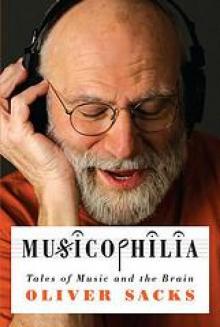 Musicophilia
Musicophilia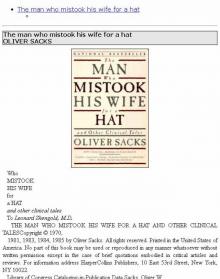 The man who mistook his wife for a hat
The man who mistook his wife for a hat 1989 - Seeing Voices
1989 - Seeing Voices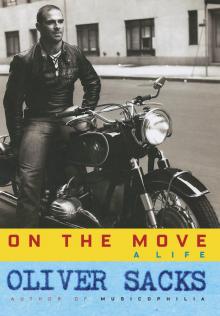 On the Move: A Life
On the Move: A Life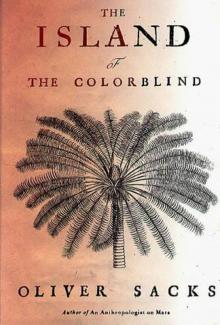 1996 - The Island of the Colorblind
1996 - The Island of the Colorblind An Anthropologist on Mars: Seven Paradoxical Tales
An Anthropologist on Mars: Seven Paradoxical Tales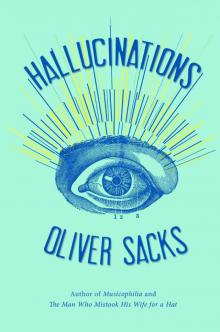 Hallucinations
Hallucinations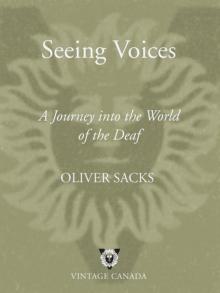 Seeing Voices
Seeing Voices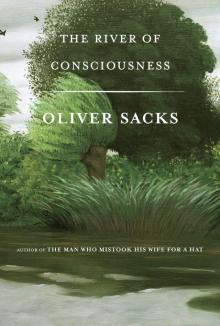 The River of Consciousness
The River of Consciousness Vintage Sacks
Vintage Sacks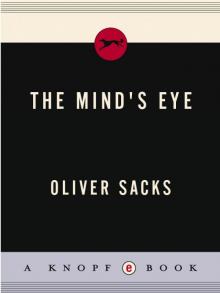 The Mind's Eye
The Mind's Eye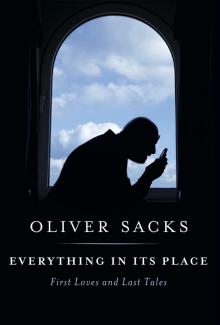 Everything in Its Place
Everything in Its Place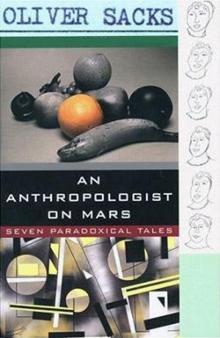 An Anthropologist on Mars (1995)
An Anthropologist on Mars (1995) Uncle Tungsten: Memories of a Chemical Boyhood (2001)
Uncle Tungsten: Memories of a Chemical Boyhood (2001)